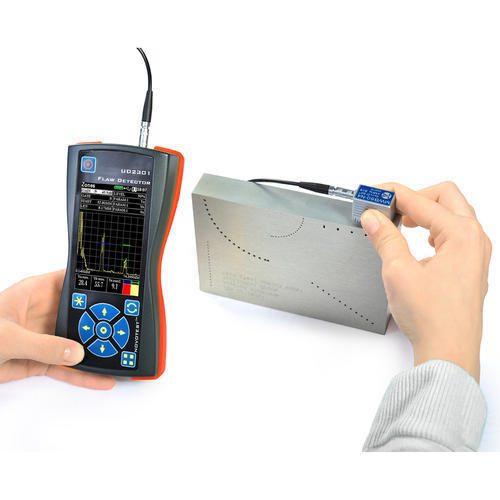Product Description
The Ultrasonic Flaw Detector is an important non-destructive testing equipment that finds hidden faults in materials found in manufacturing and construction. The action of running the waves into a material and collecting the echoes is what this device does. And if the acoustic patterns detected are different, there must be flaws, such as cracks or voids. This test is aimed at maintaining structural integrity and suspected problems of quality control and early identification of problems that may affect safety or performance which could threaten the integrity of the structure. This flaw detector is an indispensable tool for inspecting welds, metals, and composites. The extraordinary precision and efficiency of Ultrasonic Flaw Detector make it premium in a class of its own.
| Brand | PRO Engineers Novotest |
| Display Type | high resolution (320*480 pixels) |
| Weight | 250 g (without batteries) |
| Frequency | from 1 to 10,0 MHz |
| Dimension | 80x162x38 mm |
| Minimum Order Quantity | 1 Piece |
| perating frequency range | from 1 to 10,0 MHz |
| Range of measured time intervals (duration of scanning) | from 6 to 1000 s |
| Velocity range | 1000 9999 m / s |
| Error of measurement of time intervals | not exceed 0,025 s |
| Maximum permissible error of measurement of the amplitudes of the signals at the receiver input in the range from 0 to 110 dB | not exceed 0,5 dB |
| Testing gain range | 125 dB |
| Averaging over the quantity of starts | from 1 to 16 |
| Range of variation of temporal sensitivity adjustment (TVG) | 40 dB |
| Number of control points TVG | 15 |
| Duration of the excitation pulse to the load | from 0,0 to 0,5 s |
| Amplitude of the excitation pulse to the 50 Ohm load, not less | 100, 200, 300 |
| Operating frequency range of the receiver on the level -3 dB | from 1 to 10 MHz |
| Deviation of the amplitudes of input signals in the range from 10 to 100% of the screen height not more than | 1 dB |
| Scanning | from 1 to 1000 s |
| Delay of scanning | from 0 to 2000 s |
| Range of measurement of time intervals | from 0 to 1000 s |
| Setting a delay in the prism of the probe | from 0 to 15 s |
| Automatic signaling of defects (AFS) | dual-gate |
| Setting range of AFS gates | from 0 to 2000 s |
| Adjusting thresholds of AFS gates | from 0 to 100 % of screen height |
| Detection of signals | positive half-wave, radio mode |
| Dimensions (W*H*L) | 80*162*38 mm |
| Weight, not more | 250 g (without batteries) |
| Mean time between failures | not less than 3000 hours |
Ultrasonic Flaw Detector Specifications:
1. Model Name/Number: Novotest Ud2301
2. Weight: 250 g (Without Batteries)
3. Frequency: 10,0 MHz
4. Display Type: 320x480 pixels
5. Temperature: -5 Degree +65 Degree
6. Dimension: 80x162x38 mm
Ultrasonic Flaw Detector FAQ:
Q. How does an ultrasonic flaw detector work?
Ans: Ultrasonic flaw detectors emit high-frequency sound waves into a material. When these waves encounter a change in material properties, such as a crack or void, they reflect back to the detector. By analyzing the time it takes for the waves to return and their amplitude, the flaw detector can determine the size, shape, and location of defects.
Q. What materials can be tested with an ultrasonic flaw detector?
Ans: Ultrasonic flaw detectors are versatile and can be used to test a wide range of materials, including metals, plastics, composites, ceramics, and more.
Q. What types of defects can be detected with an ultrasonic flaw detector?
Ans: Ultrasonic flaw detectors can detect various defects, such as cracks, voids, inclusions, delaminations, and thickness variations, depending on the material being tested and the application.
Q. What are the main applications of ultrasonic flaw detectors?
Ans: Ultrasonic flaw detectors are commonly used in industries such as aerospace, automotive, manufacturing, construction, and oil and gas for quality control, material characterization, weld inspection, corrosion assessment, and structural integrity testing.
Q. What are the advantages of using an ultrasonic flaw detector?
Ans: Some advantages include: non-destructive testing, high sensitivity to small defects, ability to penetrate thick materials, real-time imaging capabilities, and portability.
Q. How do I choose the right ultrasonic flaw detector for my application?
Ans: Consider factors such as the material being tested, the size and type of defects you need to detect, required sensitivity and resolution, environmental conditions, and budget constraints.
Q. Can ultrasonic flaw detectors be used for underwater inspections?
Ans: Yes, there are underwater ultrasonic flaw detectors specifically designed for submerged inspections, commonly used in marine applications such as ship hull inspections and underwater infrastructure assessment.
Q. What are some common features of ultrasonic flaw detectors?
Ans: Common features include adjustable frequency settings, various waveform modes (pulse-echo, through-transmission, etc.), data recording and storage capabilities, digital display screens, and compatibility with different transducer types and sizes.
Q. How do I interpret the results obtained from an ultrasonic flaw detector?
Ans: Interpreting results requires training and expertise. Typically, defects are identified based on their location, size, amplitude, and waveform characteristics. Comparing results with standards and specifications is often necessary to determine acceptability.
 English
English Spanish
Spanish French
French German
German Italian
Italian Chinese (Simplified)
Chinese (Simplified) Japanese
Japanese Korean
Korean Arabic
Arabic Portuguese
Portuguese







 Call Me Free
Call Me Free